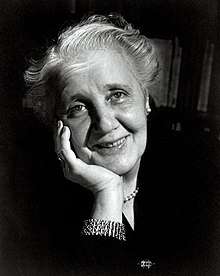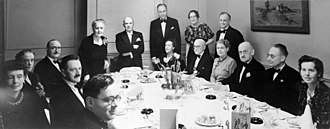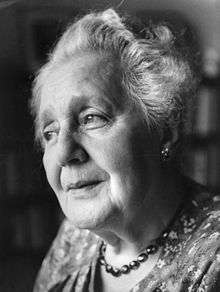Melanie Klein
| Melanie Klein | |
|---|---|
 Melanie Klein in 1952 | |
| Born |
30 March 1882 Vienna, Austria-Hungary |
| Died |
22 September 1960 (aged 78) London, England |
| Known for |
Devising therapeutic techniques for children Coining the term 'reparation' Klein's theory splitting Projective identification |
| Scientific career | |
| Fields | Psychoanalysis |
| Influences |
Sigmund Freud Karl Abraham |
| Influenced |
Herbert Rosenfeld Otto F. Kernberg Jacques Lacan Cornelius Castoriadis Donald Meltzer Wilfred Bion |
Melanie Reizes Klein (30 March 1882 – 22 September 1960) was an Austrian-British psychoanalyst who devised novel therapeutic techniques for children that influenced child psychology and contemporary psychoanalysis. She was a leading innovator in object relations theory.
Life

Born in Vienna of Jewish heritage,[1] Klein first sought psychoanalysis for herself from Sándor Ferenczi when she was living in Budapest during World War I.[2] There she became a psychoanalyst and began analysing children in 1919. Allegedly two of the first children she analysed were her son and daughter. In 1921 she moved to Berlin, where she studied with and was analysed by Karl Abraham. Although Abraham supported her pioneering work with children, neither Klein nor her ideas received much support in Berlin. However, impressed by her innovative work, British psychoanalyst Ernest Jones invited Klein to come to London in 1926, where she worked until her death in 1960.
Klein had a major influence on the theory and technique of psychoanalysis, particularly in Great Britain. As a divorced woman whose academic qualifications did not even include a bachelor's degree, Klein was a visible iconoclast within a profession dominated by male physicians.
After the arrival of Sigmund Freud and his psychoanalyst daughter Anna Freud in London in 1938, Klein’s ideas came into conflict with those of Continental analysts who were migrating to Britain. Following protracted debates between the followers of Klein and the followers of Anna Freud during the 1940s (the so-called 'controversial discussions'), the British Psychoanalytical Society split into three separate training divisions: (1) Kleinian, (2) Anna Freudian, and (3) independent.
Apart from her professional successes, Klein’s life had a number of tragic events. She was youngest of four children. Her much loved elder sister died at the age of eight, when Klein was four,[3] and she was made to feel responsible for her brother’s death. Her academic studies were interrupted by marriage and children. Her marriage failed and her son died in a climbing accident, that may have been a suicide, while her daughter, whom Klein had analysed as a child, the well-known psychoanalyst Melitta Schmideberg, fought her openly in the British Psychoanalytical Society. Her daughter's analyst at the time, Edward Glover, openly challenged Klein in the British Society meetings. Mother and daughter were not reconciled before Klein's death, and Schmideberg did not attend Klein's funeral. She was an atheist, but she never forgot her Jewish roots.[4]
Thought


Although Klein questioned some of the fundamental assumptions of Sigmund Freud, she always considered herself a faithful adherent of Freud's ideas. Klein was the first person to use traditional psychoanalysis with young children. She was innovative in both her techniques[5] (such as working with children using toys) and her theories on infant development. Strongly opinionated, and demanding loyalty from her followers, Klein established a highly influential training program in psychoanalysis. She is considered one of the co-founders of object relations theory.
Klein's theoretical work incorporates Freud's belief in the existence of the "death pulsation", reflecting the fact that all living organisms are inherently drawn toward an inorganic state, and therefore, in an unspecified sense, contain a drive towards death. In psychological terms, Eros (properly, the life pulsation), the postulated sustaining and uniting principle of life, is thereby presumed to have a companion force, Thanatos (death pulsation), which seeks to terminate and disintegrate life. Both Freud and Klein regarded these biomental forces as the foundations of the psyche. These primary unconscious forces, whose mental matrix is the id, spark the ego—the experiencing self—into activity. Id, ego and superego, to be sure, were merely shorthand terms (similar to the "instincts") referring to highly complex and mostly uncharted psychodynamic operations. Freud and Klein never abandoned the terms or the conceptualizations, despite protests from and controversies among many of their adherents.
While Freud’s ideas concerning children mostly came from working with adult patients, Klein was innovative in working directly with children, often as young as two years old. Klein saw children’s play as their primary mode of emotional communication. After observing troubled children play with toys such as dolls, animals, plasticine, pencil and paper, Klein attempted to interpret the specific meaning of play. Following Freud she emphasized the significant role that parental figures played in the child’s fantasy life, and considered that the timing of Freud’s Oedipus complex was incorrect. Contradicting Freud, she concluded that the superego was present from birth.
After exploring ultra-aggressive fantasies of hate, envy, and greed in very young and disturbed children, Melanie Klein proposed a model of the human psyche that linked significant oscillations of state, with whether the postulated Eros or Thanatos pulsations were in the fore. She named the state of the psyche, when the sustaining principle of life is in domination, the depressive position. This is considered by many to be her great contribution to psychoanalytic thought. She later developed her ideas about an earlier developmental psychological state corresponding to the disintegrating tendency of life, which she called the paranoid-schizoid position.[6]
Klein's insistence on regarding aggression as an important force in its own right when analysing children brought her into conflict with Freud's daughter Anna Freud, who was one of the other prominent child psychotherapists in continental Europe but who moved to London in 1938 where Klein had been working for several years. Many controversies arose from this conflict, and these are often referred to as the controversial discussions. Battles were played out between the two sides, each presenting scientific papers, working out their respective positions and where they differed, during war-time Britain. A compromise was eventually reached whereby three distinct training groups were formed within the British Psychoanalytical Society, with Anna Freud's influence remaining largely predominant in the US.
Today, Kleinian psychoanalysis is one of the major schools within psychoanalysis. Kleinian psychoanalysts are members of the International Psychoanalytical Association. Kleinian psychoanalysis remains a large and influential school of psychoanalysis within Britain, in much of Latin America, and to an extent in continental Europe. Within the United States of America, the Psychoanalytic Center of California is the only major training center that follows the work of Melanie Klein. Kleinian psychoanalysis with adults is characterized by the traditional method of using an analytic couch and meeting four to five times a week. Unlike Freudian psychoanalysis which focuses on the patient's ego, Kleinian analysis focuses on interpreting very "deep" and primitive emotions and fantasies from the very beginning of treatment.
In popular culture
- Melanie Klein was the subject of a 1988 play by Nicholas Wright, entitled Mrs. Klein. Set in London in 1934, the play involves a conflict between Melanie Klein and her daughter Melitta Schmideberg, after the death of Melanie's son Hans Klein. The depiction of Melanie Klein is quite unfavorable: the play suggests that Hans' death was a suicide and also reveals that Klein had analysed these two children. In the original production at the Cottesloe Theatre in London, Gillian Barge played Melanie Klein, with Zoë Wanamaker and Francesca Annis playing the supporting roles. In the 1995 New York revival of the play, Melanie Klein was played by Uta Hagen, who described Melanie Klein as a role that she was meant to play.[7] The play was broadcast on the British radio station BBC 4 in 2008 and revived at the Almeida Theatre in London in October 2009 with Clare Higgins as Melanie Klein.
- The indie band Volcano Suns dedicated their first record "The Bright Orange Years" to Klein for her work on childhood aggression.
- Scottish author Alexander McCall Smith makes extensive use of Melanie Klein and her theories in his 44 Scotland Street series. One of the characters, Irene, has an obsession with Kleinian theory, and uses it to "guide" her in the upbringing of her son, Bertie.
Bibliography

Melanie Klein's works are collected in four volumes:
- The Collected Writings of Melanie Klein
- Volume 1 – Love, Guilt and Reparation: And Other Works 1921–1945, London: Hogarth Press.
- Volume 2 – The Psychoanalysis of Children, London: Hogarth Press.
- Volume 3 – Envy and Gratitude, London: Hogarth Press.
- Volume 4 – Narrative of a Child Analysis, London: Hogarth Press.
Books on Melanie Klein:
- Robert Hinshelwood, Susan Robinson, Oscar Zarate, Introducing Melanie Klein, Icon Books UK 2003
- Robert Hinshelwood, A Dictionary of Kleinian Thought, Free Association Books UK 1989
- Robert Hinshelwood, Clinical Klein, Free Association Books UK 1993
- Melanie Klein, 'The autobiography of Melanie Klein' ed. Janet Sayers with John Forrester, Psychoanalysis and History 15.2 (2013) pp. 127–63
- Mary L Jacobus, "The Poetics of Psychoanalysis: In the Wake of Klein", Oxford University Press, 2006, ISBN 0-19-924636-X
- Julia Kristeva, Melanie Klein (European Perspectives: A Series in Social Thought and Cultural Criticism) tr. Ross Guberman, Columbia University Press, 2004
- Donald Meltzer (Information in French) "The Kleinian Development (New edition)", Publisher: Karnac Books; Reprint edition 1998, ISBN 1-85575-194-1
- Donald Meltzer : "Dream-Life: A Re-Examination of the Psycho-Analytical Theory and Technique" Publisher: Karnac Books, 1983, ISBN 0-902965-17-4
- Meira Likierman, "Melanie Klein, Her Work in Context" Continuum International, Paperback, 2002
- Hanna Segal (Information in French):
- "Klein" Publisher: Karnac Books; Reprint edition (1989) ISBN 0-946439-69-9
- "The Work of Hanna Segal: A Kleinian Approach to Clinical Practice (Classical Psychoanalysis and Its Applications) " Publisher: Jason Aronson, 1993), ISBN 0-87668-422-3
- "Dream, Phantasy and Art" Publisher: Routledge; 1 edition 1990, ISBN 0-415-01798-X
- Transcript of a seminar titled "Motivation: the artist and the psychoanalyst"
- John Steiner (Information in French) : "Psychic Retreats" (...) relative peace and protection from strain when meaningful contact with the analyst is experienced as(...), Publisher: Routledge; 1993, ISBN 0-415-09924-2
- C. Fred Alford, Melanie Klein and Critical Social Theory: An Account of Politics, Art, and Reason Based on Her Psychoanalytic Theory, Yale UP 1990
- Phyllis Grosskurth, Melanie Klein: Her World and Her Work, Alfred A. Knopf, Inc., 1986, ISBN 1-56821-445-6
- Rose, Jacqueline (1993). Why war?: psychoanalysis, politics, and the return to Melanie Klein. Oxford, UK Cambridge, Mass., USA: B. Blackwell. ISBN 9780631189244.
- Herbert Rosenfeld (Information in French): * "Impasse and Interpretation: Therapeutic and Anti-Therapeutic Factors in the Psycho-Analytic Treatment of Psychotic, Borderline, and Neurotic Patients", Publisher: Tavistock Publications, 1987, ISBN 0-422-61010-0
- Julia Segal: (1992). Melanie Klein. London: Sage. ISBN 0-8039-8477-4
- Ronald Britton: "Sex, Death, and the Superego: Experiences in Psychoanalysis", Publisher: Karnac Books; 2003, ISBN 1-85575-948-9
- Ronald Britton: "Belief and Imagination", Publisher: Taylor & Francis LTD; 1998, ISBN 0-415-19438-5
- Monique Lauret et Jean-Philippe Raynaud, "Melanie Klein, une pensée vivante", Presses Universitaires de France, 2008, ISBN 978-2-13-057039-4
- Mitchell, Juliet (editor); Klein, Melanie (author) (1987). The selected Melanie Klein. New York: Free Press. ISBN 9780029214817.
See also
References
- ↑ Concise Dictionary of National Biography
- ↑ See Klein, Melanie (2013). "'The autobiography of Melanie Klein' ed. Janet Sayers with John Forrester". Psychoanalysis and History. 15 (2): 127–63.
- ↑ Hughes, Judith. Reshaping the Psychoanalytic Domain: The Work of Melanie Klein, W.R.D. Fairbairn, & D.W. Winnicott. University of California Press. p. 9. ISBN 9780520071889.
- ↑ "Melanie Klein". faculty.webster.edu. Retrieved 2 April 2018.
- ↑ Horacio Etchegoyen: The Fundamentals of Psychoanalytic Technique, Karnac Books ed., New Ed, 2005, ISBN 1-85575-455-X
- ↑ Dillon, M. C. (1978). "Merleau-Ponty and the Psychogenesis of the Self". Journal of Phenomenological Psychology. 9: 84. doi:10.1163/156916278X00032.
- ↑ Ben Brantley,"Theater Review: Uta Hagen returns, tossing Wine," New York Times, 25 October 1995.
Further reading
- Phyllis Grosskurth, Melanie Klein: Her World and Her Work, Alfred A. Knopf, Inc., 1986, ISBN 1-56821-445-6
External links
| Library resources about Melanie Klein |
| By Melanie Klein |
|---|


- Melanie Klein in the Encyclopædia Britannica
- Biography, psychoanalytic techniques, theory
- Melanie Klein Trust
- Biography at FeministVoices.com